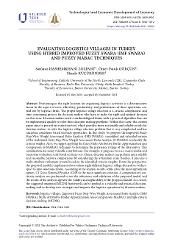| dc.contributor.author | Hashemkhani Zolfani, Sarfaraz | |
| dc.contributor.author | Gorcun, Omer Faruk | |
| dc.contributor.author | Kucukonder, Hande | |
| dc.date.accessioned | 2023-10-19T15:13:01Z | |
| dc.date.available | 2023-10-19T15:13:01Z | |
| dc.date.issued | 2021 | |
| dc.identifier.issn | 2029-4913 | |
| dc.identifier.issn | 2029-4921 | |
| dc.identifier.uri | https://doi.org/10.3846/tede.2021.16004 | |
| dc.identifier.uri | https://hdl.handle.net/20.500.12469/5590 | |
| dc.description.abstract | Positioning in the right location for organizing logistics activities is a determinative factor in the aspect of costs, effectivity, productivity, and performance of these operations carried out by logistics firms. The proper logistics village selection is a crucial, complicated, and time-consuming process for decision-makers who have to make the right and optimal decision on this issue. Decision-makers need a methodological frame with a practical algorithm that can be implemented quickly to solve these decision-making problems. Within this scope, the current paper aims to present an evaluation tool, which provides more reasonable and reliable results for decision-makers to solve the logistics village selection problem that is very complicated and has uncertain conditions based on fuzzy approaches. In this study, we propose the Improved Fuzzy Step-Wise Weight Assessment Ratio Analysis (IMF SWARA), a modified and extended version of the traditional fuzzy Step-Wise Weight Assessment Ratio Analysis (F-SWARA) to identify the criteria weights. Also, we suggest applying the fuzzy Multi-Attributive Border Approximation area Comparison (F-MABAC) technique to determine the preference ratings of the alternatives. This combination has many valuable contributions. For example, it proposes to use a more reliable and consistent evaluation scale based on fuzzy sets. Hence, decision-makers can perform more reliable and reasonable pairwise comparisons by considering this evaluation scale. Besides, it presents a multi-attribute evaluation system based on the identified criteria weights. From this perspective, the proposed model is implemented to evaluate eight different logistics village alternatives with respect to nine selection criteria. According to the analysis results, while A8 is the most appropriate option, C1 Gross National Product (GNP) is the most significant criterion. A comprehensive sensitivity analysis was performed to test the robustness and validation of the proposed model, and the results of the analysis approve the validity and applicability of the proposed model. As a result, the suggested integrated MCDM framework can be applied as a valuable and practical decisionmaking tool to develop new strategies and improve the logistics operations by decision-makers. | en_US |
| dc.language.iso | eng | en_US |
| dc.publisher | Vilnius Gediminas Tech Univ | en_US |
| dc.relation.ispartof | Technological and Economic Development of Economy | en_US |
| dc.rights | info:eu-repo/semantics/openAccess | en_US |
| dc.subject | Decision-Making | En_Us |
| dc.subject | Location Selection | En_Us |
| dc.subject | Site Selection | En_Us |
| dc.subject | Transport | En_Us |
| dc.subject | Moora | En_Us |
| dc.subject | Model | En_Us |
| dc.subject | Ahp | En_Us |
| dc.subject | logistics villages | en_US |
| dc.subject | Improved Fuzzy Step-Wise Weight Assessment Ratio Analysis (IMF SWARA) | en_US |
| dc.subject | Multi-Attributive Border Approximation Area Comparison (MABAC) | en_US |
| dc.subject | multiple criteria decision making (MCDM) | en_US |
| dc.title | EVALUATING LOGISTICS VILLAGES IN TURKEY USING HYBRID IMPROVED FUZZY SWARA (IMF SWARA) AND FUZZY MABAC TECHNIQUES | en_US |
| dc.type | article | en_US |
| dc.identifier.startpage | 1582 | en_US |
| dc.identifier.endpage | 1612 | en_US |
| dc.identifier.issue | 6 | en_US |
| dc.identifier.volume | 27 | en_US |
| dc.department | N/A | en_US |
| dc.identifier.wos | WOS:000741983200002 | en_US |
| dc.identifier.doi | 10.3846/tede.2021.16004 | en_US |
| dc.identifier.scopus | 2-s2.0-85121244323 | en_US |
| dc.institutionauthor | N/A | |
| dc.relation.publicationcategory | Makale - Uluslararası Hakemli Dergi - Kurum Öğretim Elemanı | en_US |
| dc.authorwosid | Zolfani, Sarfaraz Hashemkhani/AAA-9918-2021 | |
| dc.authorwosid | Gorcun, Omer Faruk/ADF-0541-2022 | |
| dc.khas | 20231019-WoS | en_US |
















